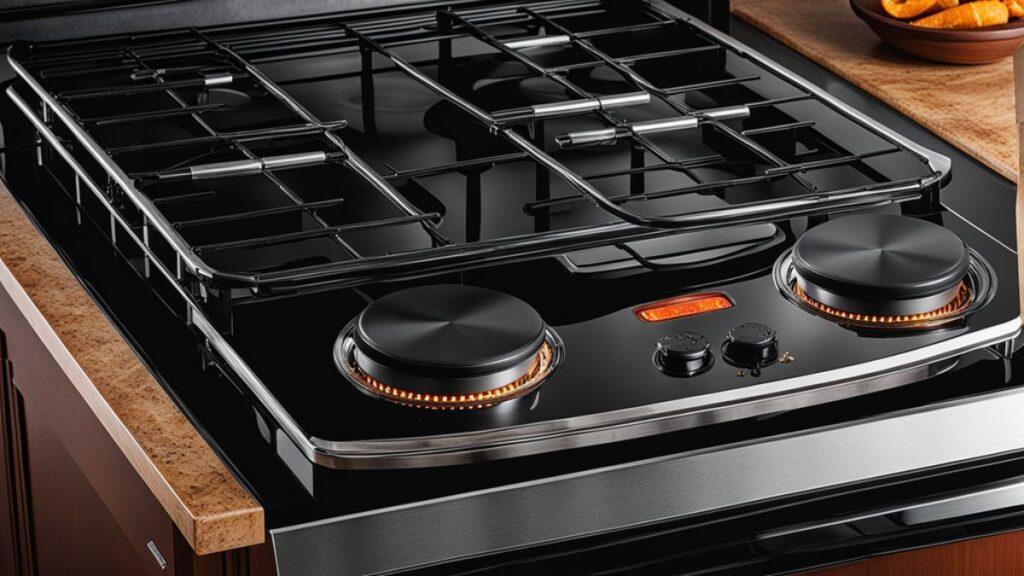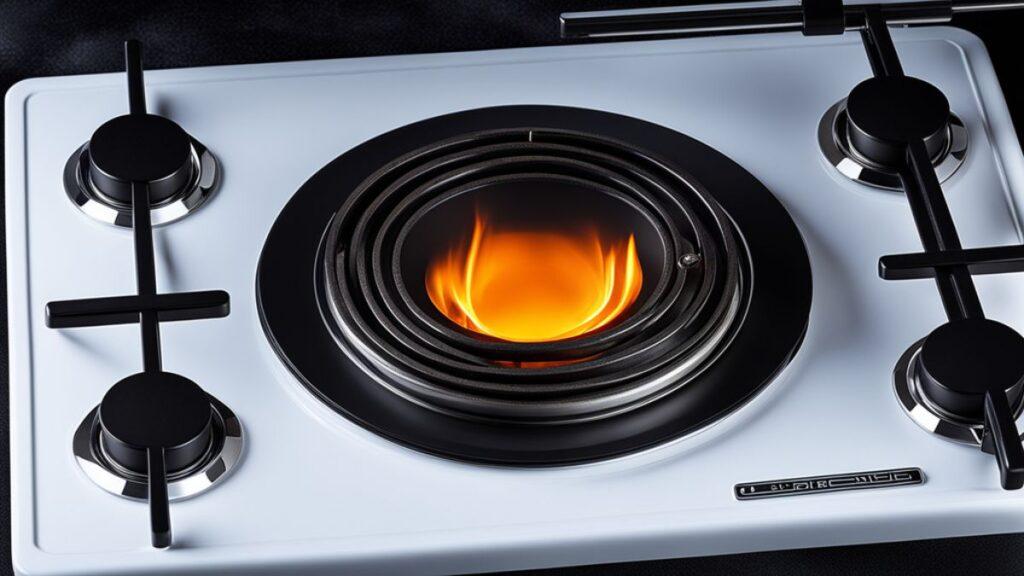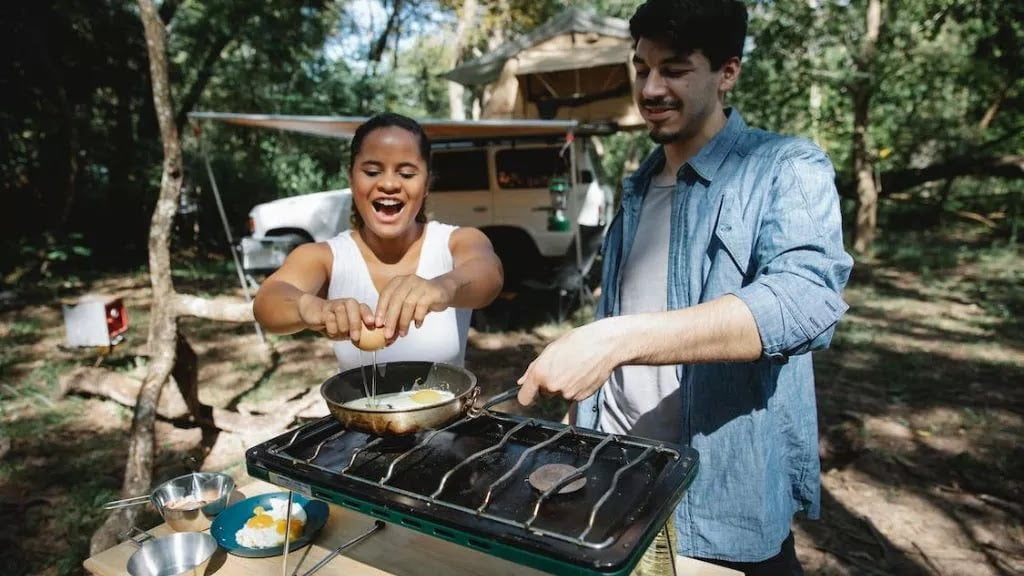
We may earn money or products from the companies mentioned in this post.
An electric stove burner can reach temperatures up to 1,500 degrees Fahrenheit. Different settings allow for varying heat levels.
Understanding the heat output of electric stove burners is essential for both cooking precision and kitchen safety. Electric burners provide a controlled, consistent source of heat, using coils or radiant heating elements. They typically offer a range of temperatures from a low simmer to a high heat, which accommodates a wide array of cooking techniques.
By turning the dial, users can adjust the temperature to suit various recipes, from gently melting chocolate to searing a steak. This flexibility makes electric stoves a popular choice in home kitchens. Seasoned cooks and novices alike benefit from knowing their appliance’s capabilities, ensuring dishes are perfectly prepared while also preventing accidental burns or overheating.
Read More: Electric Stove Element Temperature Control: Heat Mastery!

Credit: www.amazon.com
Electric Stove Burner Basics
Exploring the electric stove burner reveals the simplicity and efficiency behind this common kitchen appliance.
Components Of An Electric Burner
Understanding electric stove tops is key to their safe and effective use. Key parts include:
- Coil Burners – Spiral metal elements that heat up.
- Solid Burners – Smoothtop elements under glass ceramic.
- Internal Wiring – Transfers electricity to heat the burner.
- Temperature Control – Knobs that adjust heat levels.
- Indicator Lights – Show when burners are active.
How Electric Stoves Generate Heat
The heating process of electric stoves turns electricity into warmth:
- Electricity flows into the burner’s wiring.
- Resistance in the coils or solid plates converts electricity to heat.
- Heat transfers to the pot or pan above.
This transfer of energy makes cooking with electric stoves practical.
Read More: How Hot Does an Electric Stove Burner Get: Sizzling Facts!
Temperature Ranges On Electric Stoves

Curious about how hot your electric stove burner can get? Understanding the temperature ranges of electric stoves is essential for perfect cooking. The burner temperature can vary greatly, affecting how dishes are cooked. From a light simmer to searing heat, here’s a breakdown of what to expect from your stove’s settings.
Low Heat Settings
Low heat on an electric stove is perfect for slow cooking and simmering. This range is ideal for dishes that need gentle cooking, like sauces or stews. Expect temperatures of:
- Warm: 150°F to 200°F
- Low: 200°F to 250°F
Medium Heat Settings
Medium heat strikes a balance, being the go-to for everyday cooking. It’s the sweet spot for sauteeing veggies or cooking pancakes. Medium heat generally offers:
- Medium-Low: 250°F to 300°F
- Medium: 300°F to 350°F
- Medium-High: 350°F to 400°F
High Heat Settings
High heat on your electric stove burner is the powerhouse for boiling water and searing meat. These temperatures are intense and fast to cook:
- High: 400°F to 450°F
- Very High: 450°F to 550°F
Maximum Heat Output
The maximum heat output of electric stove burners can vary by model. But, typically, the top range is around:
- Max Heat: 550°F to 650°F
These temps are great for quick sears and fast boiling.
Read More: How Hot Does an Electric Stove Get: Sizzling Facts!
Factors Affecting Stove Burner Heat

Understanding the elements that impact your electric stove burner’s heat is crucial. It helps you cook better and faster. Not all burners work the same way. Many little things you might not notice affect their heat. Let’s look at two big factors.
Burner Size And Wattage
Different burners mean different heat. Your electric stove might have small or big burners. Or both. Each has its own power level. We call this wattage. Wattage shows how much electricity turns into heat. More watts make more heat.
| Burner Size | Average Wattage |
|---|---|
| Small | 1200 Watts |
| Large | 2500 Watts |
Small burners are perfect for sauces or small pans. Large burners are good for boiling water fast. For the best cooking, pick the right burner size for your pot or pan.
Material And Construction Of Cookware
Not all pots and pans are the same. They can be metal, ceramic, or even glass. How fast they heat up on your stove burner depends on the material. Here’s a tip: Use flat-bottomed cookware. It touches more of the burner. This means more even cooking.
- Aluminum: Heats fast but can cool quickly too.
- Cast Iron: Takes time to heat but keeps it well.
- Stainless Steel: Balanced heat, good choice.
- Copper: Quick heat, but changes temperature fast.
Remember, your choice can change how your food cooks. Match the cookware to what you’re making. It makes a big difference!
Read More: How Hot Can an Electric Stove Get: Sizzling Facts!
Measuring Stove Burner Temperature
Understanding the temperature of your electric stove burner can be crucial for cooking success. Knowing exactly how hot the burner is lets you cook foods correctly. To measure the stove burner temperature accurately, you can use a couple of methods.
Using An Infrared Thermometer
To directly measure the temperature of your electric stove burner, an infrared thermometer is your best bet.
- Turn on the stove and set it to the desired level.
- Point the infrared thermometer at the center of the burner.
- Wait for the thermometer to provide a temperature reading.
Infrared thermometers give a precise temperature without touching the surface. They can measure high heat levels quickly and safely.
Visual Cues And Cooking Times
You can also use visual cues and cooking times as indicators of burner temperature.
| Heat Setting | Visual Cue | Typical Cooking Time |
|---|---|---|
| Low | Light glow | Slow cooking |
| Medium | Brighter, steady glow | Regular frying |
| High | Intense bright glow | Fast boiling |
For instance, a low heat setting will show merely a light glow and is ideal for slow cooking. Conversely, an intense bright glow indicates a high heat setting for tasks like boiling water.
Read More: How Hot Can an Electric Stove Burner Coil Get: Sizzling Facts!
Safety Tips When Handling Hot Burners
Understanding the heat range of an electric stove burner is critical for kitchen safety. Electric burners can reach temperatures upwards of 500°F, so using oven mitts and exercising caution is imperative. Always keep flammable materials away while the stove is in use to prevent accidents.
Electric stove burners can get extremely hot. To help protect your family, follow these safety tips. Your knowledge could prevent a burn or even a fire.
Preventing Burns And Fires
- Stay in the kitchen while cooking to watch for any signs of trouble.
- Use rear burners first, reducing the chance of accidental contact.
- Turn pot handles away from the edge to avoid knocks and spills.
- Keep items that can catch fire, like towels and paper, away from the burner.
- Put on oven mitts before touching pots or stove controls.
- Teach kids that stoves are off-limits and mark a safety boundary.
Proper Maintenance To Avoid Accidents
- Regularly inspect your stove for any damage or issues.
- Clean spills immediately to prevent residue build-up, which can catch fire.
- Ensure electrical connections are secure to prevent malfunctions.
- Use the stove for intended purposes only—no storage on top or inside.
- Have a certified technician check your stove if you notice any problems.
Remember to always approach hot burners with caution and prioritize safe kitchen practices.

Credit: www.americastestkitchen.com
Enhancing Your Cooking With Optimal Heat
Knowing how hot your electric stove burner gets can really upgrade your culinary game. Whether you’re whipping up a swift breakfast or crafting a gourmet dinner, the temperature of your stove can make or break the outcome. Let’s dive into mastering the art of heat control to turn good dishes into great ones.
Selecting The Right Temperature For Different Foods
Each dish requires a specific flame. Picking the right one is crucial.
| Food Type | Temperature Range | Stove Setting |
|---|---|---|
| Boiling Water | 212°F (100°C) | High |
| Scrambled Eggs | 250-300°F (121-149°C) | Medium-Low |
| Steak Searing | 400-450°F (204-232°C) | Medium-High |
Use this table as a guide. Remember to preheat pans for even cooking.
Timing And Heat Adjustment For Recipes
- Start High, End Low: Begin with a high temperature to sear meats, then lower the heat to finish.
- Simmer Sauces with Care: Keep sauces on a low flame to avoid burning.
- Rest Your Cookware: Allow pans to cool slightly when switching between high and low temperatures.
These timings and adjustments are key. Pay attention and adjust as needed for perfect meals.
Frequently Asked Questions Of How Hot Is An Electric Stove Burner
What Temperature Does A Stove Burner Reach?
How To Measure Heat Output Of Electric Burners?
Can Electric Stove Burners Overheat?
What Affects An Electric Stove Burner’s Temperature?
Conclusion
Understanding the temperature range of electric stove burners is crucial for kitchen safety and culinary success. Whether simmering sauces or searing steaks, knowledge is power. Keep a thermometer handy, and always monitor the heat. This way, you can cook confidently, knowing your electric stove burner is just the right temperature.






